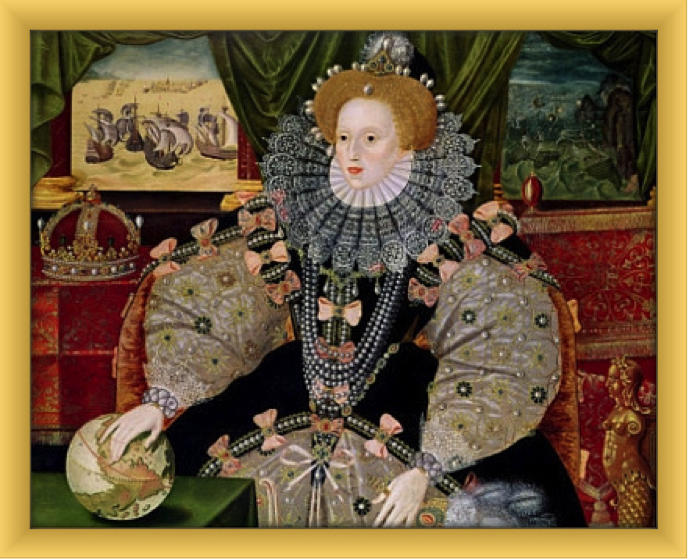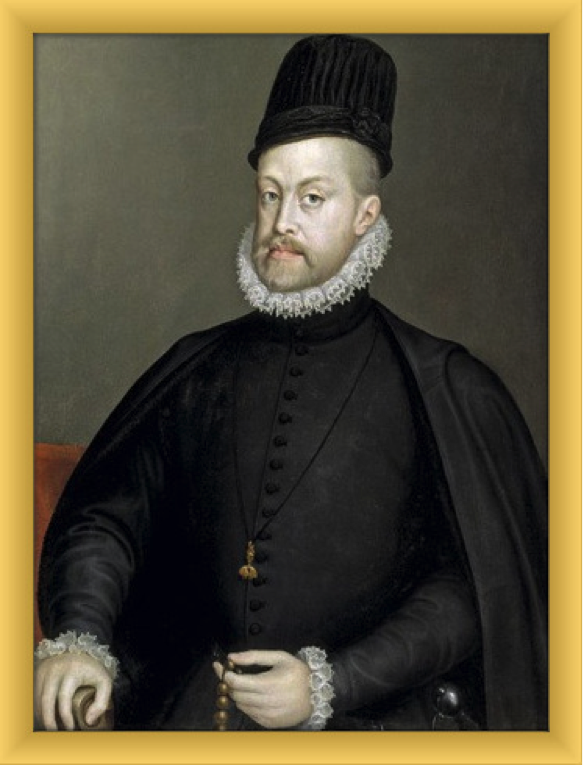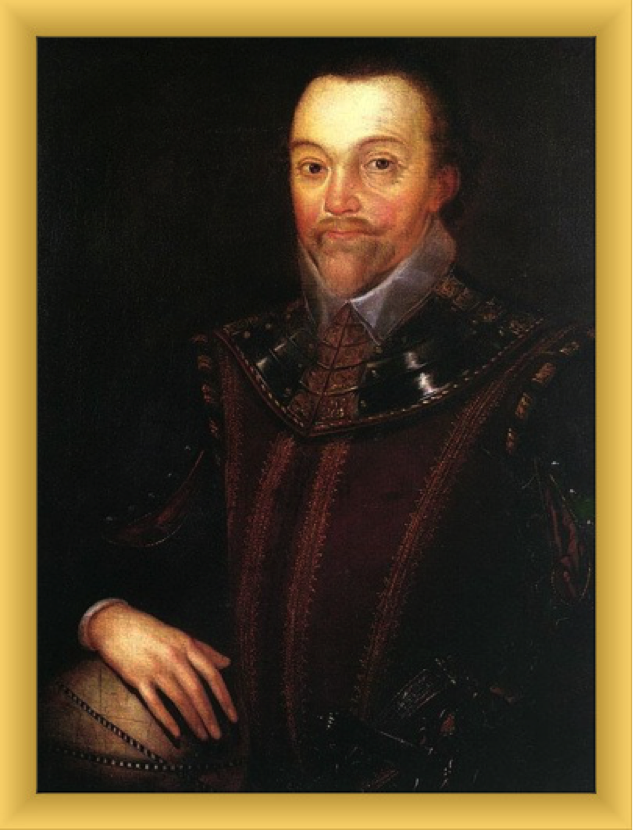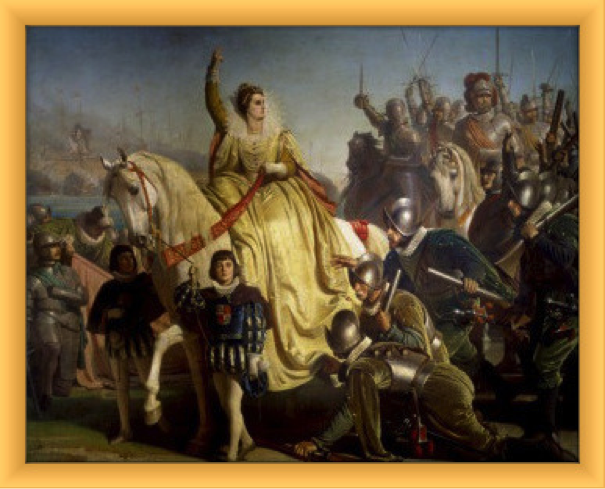by Heather Sharnette

Queen Elizabeth I The Armada Portrait
The defeat of the Spanish Armada is one of the most famous events in English history. It was arguably Queen Elizabeth’s finest hour. For years she had been hailed as the English Deborah, the savior of the English people, and now it seemed that this is what she had really become. She was now Bellona, the goddess of war, and in triumph she had led her people to glory, defeating the greatest power in the 16th century world.
Spain was the most powerful country in the world. Philip II ruled vast territories of land, and had unparalleled wealth from the New World. England was a small country, with little wealth, few friends, and many enemies. If Queen Elizabeth ever felt nervous about challenging the greatest power in the known world, she never showed it, and appeared to believe completely in the devotion and loyalty of her people. By believing in them, they believed in her.
Although relations between Spain and England had begun rather well, with Philip even proposing marriage to the English Queen, over the 30 years since the Queen’s accession, relations had deteriorated. There were many reasons for this. To begin with, England was a Protestant country, and Spain was a Roman Catholic one. The Spanish made no secret of their hostility to the English Queen, who they believed was illegitimate and had no right to the English throne, and had been involved in plots to dethrone her. Elizabeth herself had encouraged the activities of the English pirates, who plundered Philip’s ships as they made their way from the New World, seizing their treasures. This had angered Philip immensely, especially as the stolen treasure was used to help fund those people rebelling against his rule in the Netherlands.

King Philip II
As early as 1585, Philip had begun to prepare a great fleet that, under the Spanish commander Santa Cruz, would invade England. At first the aim of the Armada was to liberate the captive Queen of Scots, but when Mary was executed for conspiring Elizabeth’s death in 1587, Philip planned to invade England in the name of his daughter, the Infanta Isabella. Philip believed he had a genuine claim to the English throne, both by descent from John of Gaunt, and as Queen Mary I’s husband. The purpose of the mission was to depose Elizabeth, put Mary/Isabella on the throne, and make England Roman Catholic once again.
It was perhaps an omen, however, that from the start, the Spanish faced problems. Santa Cruz died, and his successor, the Duke of Medina Sedonia, was not at all suited to the post. He had little faith in the enterprise and little experience. He begged Philip to release him from the charge, but the King was adamant. The enterprise had received another setback when Francis Drake and his men had sailed to the coast of Spain and destroyed many of the Spanish ships at Cadiz.
Queen Elizabeth had heard mutterings of the intended invasion of England by Spain for some time. She was not, however, at first concerned about the rumors. She had heard such rumors for almost 30 years, and easily dismissed them. Her Councilors were not so dismissive. It eventually became clear to Elizabeth, however, that this time, the Spanish were really going to send a fleet against England. Although the Queen had spent considerable amounts of money funding the Netherlands campaign, she now employed all her efforts in raising funds to ensure that when the Spanish fleet came, England would be prepared.

Sir Francis Drake
Despite numerous setbacks the Spanish had received, they were determined to set a fleet against England, and in the May of 1588 at last the great fleet set out.
The plans of the Spanish were meticulous. It was planned that the Spanish fleet, consisting of over 100 ships, would sail up from Spain along the English Channel and meet with the forces of the Duke of Parma, Philip’s nephew, making their way from the Netherlands. Together they would sail towards England. It was believed that this force would overwhelm the English. The English would be conquered, and the heretical Queen would be captured.
But the English were waiting. On the cliffs of England and Wales, men watched the seas day and night, waiting for the first sighting of the great Armada. When at last the great ships appeared on the horizon, beacons were lit on the hillsides, which sent the message over the cliffs and throughout the country that the Spanish were coming. The beacons sent the message quicker than any horseman could ever ride, and by morning, London and the Queen knew that the day of reckoning had come. As soon as the ships began to make their way up the channel, the fighting began.

Queen Elizabeth at Tilbury
While English soldiers and sailors fought for England’s liberty, Queen Elizabeth made her way to Tilbury. She was not going to sit trembling inside a guarded Palace while her people fought, but was going to go to the coast of the battle and “live or die” with them. Like a true warrior Queen, Elizabeth, upon a White Horse, inspected her soldiers, and made what was possibly her most famous speech of all.
The Queen’s confidence in God and her people was rewarded. In the English Channel, the Spanish were suffering a humiliating defeat. The weather was dreadful, with the wind and rain against them, and they were not able to compete with the superior English ships and war tactics. They fled in terror when fire ships were aimed at them. The only way back to Spain was the perilous journey around the coast of Scotland, and many a Spaniard never saw his home country again. The battle was over, the English had won.
The Queen and her people were jubilant. No more were they a second rate sea power, for they had conquered the fleet of the mighty Spanish Empire. A thanksgiving service was held at St. Paul’s Cathedral for the delivery of the country, and a medal was struck with the words “God blew and they were scattered” inscribed on it. They believed that the storm that had besieged the Spanish ships was no ordinary storm, but the work of a Protestant God.
But amongst the joy, there was considerable sorrow for the Queen. The Earl of Leicester, who had been her companion since her accession, and who she undoubtedly loved, had died unexpectedly not long after sharing with her the great victory. The Queen was devastated and secluded herself for a while. In the Armada portrait she reputedly wears the pearls he left her in his will. But her people needed her, and despite her grief, the Queen participated fully in the celebrations at St. Paul’s. “God bless you my people” she called out, and her people called a thousand blessings on her.
Although King Philip sent other fleets against England in the 1590’s, none was as significant, or as threatening as that of the great Armada of 1588, and none has captured the imagination of successive generations as much.
